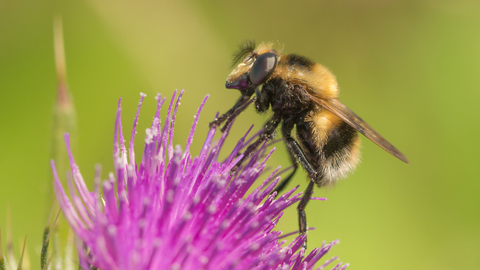
Volucella bombylans © Janet Packham
Bumblebee mimic hoverfly
Scientific name: Volucella bombylans
This furry hoverfly does an impressive job of impersonating a bee.
Species information
About
The bumblebee mimic hoverfly, sometimes known as the bumblebee plumehorn, is a common sight across the UK in late spring and summer. As its name suggests, it does an impressive job of mimicking a bumblebee, complete with a furry body. They're often found along hedgerows and the edges of woodland, or in scrubby areas. They visit a wide range of flowers, including thistles and brambles. Males are highly territorial and will defend their favourite sunlit leaf from other males, occasionally darting out to look for females.How to identify
This fairly large hoverfly looks very similar to a bee, with fuzzy hairs covering its body. There are a few features that give it away as a hoverfly: it has larger eyes, shorter antennae and only one pair of wings. It can be told from most other bee mimicking hoverflies by the plume-like bristles extending from its antennae.There are two common forms of this bumblebee mimic. Some are mostly black with a reddish-orange patch at the end of the abdomen, resembling a red-tailed bumblebee. Others are black with yellow bands and a white patch at the end of the abdomen, more like a white-tailed bumblebee.
